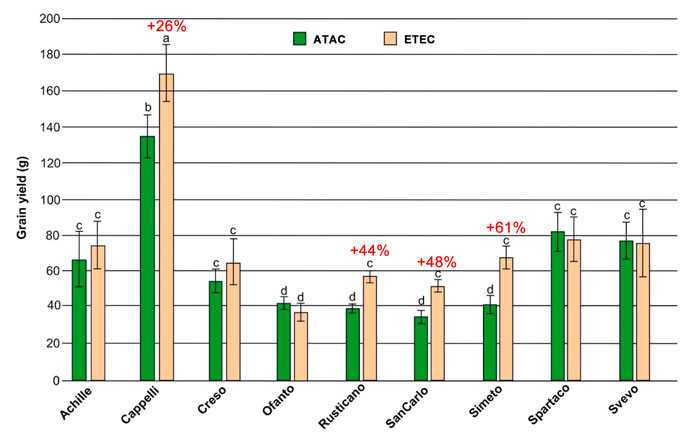| Tweet | Follow @co2science |
Paper Reviewed
Sabella, E., Aprile, A., Negro, C., Nicoli, F., Nutricati, E., Vergine, M., Luvisi, A., De Bellis, L. 2020. Impact of climate change on durum wheat yield. Agronomy 10, 793; doi:10.3390/agronomy10060793.
According to Sabella et al. (2020), "understanding the variability in plant responses to elevated concentrations of atmospheric CO2 is of great importance in breeding or selecting the best genotypes for future climatic conditions" if the world is going to be able to feed its growing population a few short decades from now. And so it was that this team of eight Italian researchers set out to investigate the response of nine durum wheat cultivars (Achille, Cappelli, Creso, Ofanto, Rusticano, San Carlo, Simento, Spartaco and Svevo) to a simulated increase in atmospheric CO2 and temperature.
In doing so the scientists grew the cultivars hydroponically in environment-controlled chambers under "one of the worst scenarios" predicted for future climate change by 2070, RCP8.5, for a full growing season. The control treatment (ATAC) included normal growing season ambient temperatures and ambient CO2 concentrations (400 ppm). The experimental treatment (ETEC) included temperatures that were 2.5 °C above control and elevated CO2 concentrations twice that of control conditions (i.e., 800 ppm).
The results of the study revealed that plants in the ETEC treatment completed their life cycle by an average of two weeks earlier than their respective cultivars grown in the ATAC treatment control. With regard to this observation Sabella et al. say "this strategy could help plants to escape the high temperatures of Mediterranean summers, so that the harvest time in 2070 could be at the end of May instead of mid/end-June."
Another agronomic parameter measured was plant height. Here, the researchers report this variable was unaffected by the elevated temperature and elevated CO2 treatment. With respect to plant dry weight, the total dry biomass was enhanced in 8 of the 9 cultivars (the ninth showed no change), albeit only significantly in two (Cappelli and Simeto, with 26% and 57% increases, respectively).
The most significant parameter, however, when it comes to feeding the world is grain yield. As shown in Figure 1 below, there was no significant difference in this variable among treatments in five of the cultivars. In contrast, four cultivars experienced significant increases in response to the high temperatures and atmospheric CO2 level. Cappelli, Rusticano, San Carlo and Simeto grain yields were enhanced by 26%, 44%, 48% and 61%, respectively, relative to their controls.
The significance of the above findings is two-fold. First, in this worse-case climatic scenario for the future, none of the nine cultivars experienced declining yields while four experienced significant increases. This observation demonstrates it is highly unlikely that agriculturally-grown durum wheat grain yields will decline in the future and that they will most likely increase as farmers select and grow the genotypes that are most responsive to rising temperatures and atmospheric CO2 concentrations. Second, this study further illustrates the power and ability of plants to cope with higher temperatures at higher levels of CO2. As demonstrated in numerous studies, higher CO2 levels almost always activate multiple ameliorative mechanisms in plants to help them counter the effects of high temperature stress.

Figure 1. Grain yield of nine durum wheat cultivars grown hydroponically under ambient temperature and ambient CO2 conditions (ATAC; ambient temperature and 400 ppm CO2) or under elevated temperature and elevated CO2 (ETEC; ambient +2.5°C and 800 ppm CO2). The percentages in red indicate the percent yield enhancement in the ETEC treatment over the ATAC treatment for those cultivars that had significant yield increases. Source: Sabella et al. (2020).




